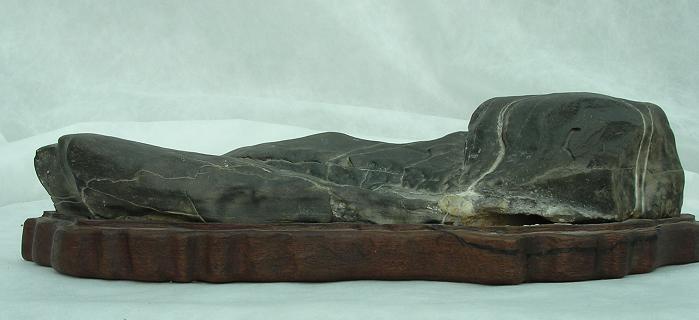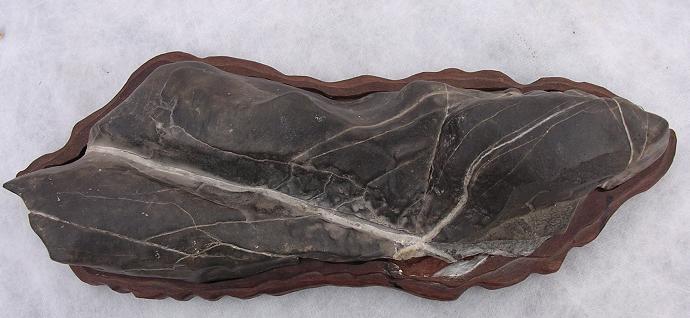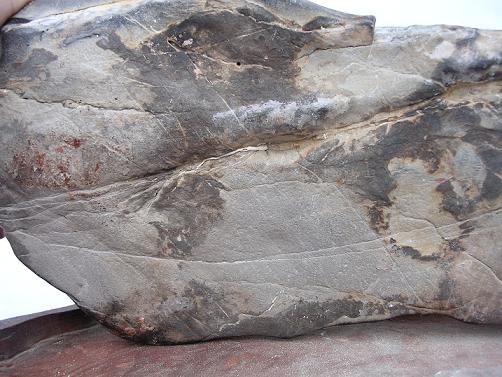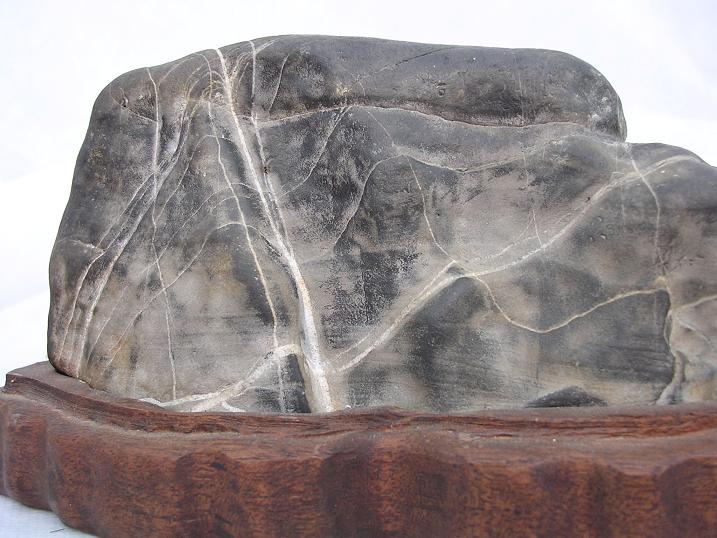A stone i found near were i live
+4
Joe Hatfield
Chris Cochrane
Yvoune
jamesransom
8 posters
Page 1 of 1
 Yoseki is not high on the list
Yoseki is not high on the list
Hi Chris and Marco
Thank you for your feed back and all your helpful comments. I will look again in the area and see what i can find. if i find any thing of interest i will post it here so you can see.
I feel that (in my opinion) is a true stone is one you find complete and not a part cut off. It feels like wrecking a bigger part for a smaller part in some cases or like its a short cut in some way (just my opinion and not entending to offend anyone). Anyway i may well have made a rod for my back in this way but its more fun.
i had read that if you rub the stone with........................ wait for it.......................... no not that ................ your hands, it helps build up the patina or luster in the stone.
................ your hands, it helps build up the patina or luster in the stone.
I will take some more shots of it in normal day light tomorrow.
Thank you
James
Thank you for your feed back and all your helpful comments. I will look again in the area and see what i can find. if i find any thing of interest i will post it here so you can see.
I feel that (in my opinion) is a true stone is one you find complete and not a part cut off. It feels like wrecking a bigger part for a smaller part in some cases or like its a short cut in some way (just my opinion and not entending to offend anyone). Anyway i may well have made a rod for my back in this way but its more fun.
i had read that if you rub the stone with........................ wait for it.......................... no not that
 ................ your hands, it helps build up the patina or luster in the stone.
................ your hands, it helps build up the patina or luster in the stone.I will take some more shots of it in normal day light tomorrow.
Thank you
James

jamesransom- Member
 Re: A stone i found near were i live
Re: A stone i found near were i live
James,
in this forum all the people help generously and sincerly with his hearth.
This said, I suggest you rub with a cotton cloth or with nature (water and sun) but not with your hands
because your hands have grease and grease is like oil.
Your stone has already a good color, you need only a little more of patina,nothing but that.
Have a fun day,
marco
in this forum all the people help generously and sincerly with his hearth.
This said, I suggest you rub with a cotton cloth or with nature (water and sun) but not with your hands
because your hands have grease and grease is like oil.
Your stone has already a good color, you need only a little more of patina,nothing but that.
Have a fun day,
marco
furuya- Member
 Re: A stone i found near were i live
Re: A stone i found near were i live
James,
I know much this kind of stones, with your new pictures I see what we have many times i.e. white marks
on surface difficult to take away because they go inside stone's porosity. This is the effect of many sun,
the clays infiltrate surface and melt with limestone: only here you can use acid muriatic with caution and
protection: one month ago I sent a stone like this one (a gift for a friend) discovered in French mountains,
she told me one week after that she cannot take away these same marks, I suggested the acid, she left
the stone one night on acid with 30% of it, the day after she had three stones, calcite evaporated,
but the marks easily gone away with a metallic brush.
Before to do that, try to use a metallic brush always maintaining wet the stone.
The front is without doubt first pic, your daiza is a bit too high and heavy but for your first stone you can be
proud.
I'm sure you can find other specimens if you search with wisdom.
Best wishes,
marco
I know much this kind of stones, with your new pictures I see what we have many times i.e. white marks
on surface difficult to take away because they go inside stone's porosity. This is the effect of many sun,
the clays infiltrate surface and melt with limestone: only here you can use acid muriatic with caution and
protection: one month ago I sent a stone like this one (a gift for a friend) discovered in French mountains,
she told me one week after that she cannot take away these same marks, I suggested the acid, she left
the stone one night on acid with 30% of it, the day after she had three stones, calcite evaporated,
but the marks easily gone away with a metallic brush.
Before to do that, try to use a metallic brush always maintaining wet the stone.
The front is without doubt first pic, your daiza is a bit too high and heavy but for your first stone you can be
proud.
I'm sure you can find other specimens if you search with wisdom.
Best wishes,
marco
furuya- Member
 Re: A stone i found near were i live
Re: A stone i found near were i live
Hi James... Marco's advice sounds reasonable & experienced to me. I like the stone best from the first view you gave us in the original post-- looking slightly downward as well as in front of it. Though a landscape stone's horizon line might look attractive, it is a rarely seen perspective for viewing a suiseki. A frontal, low angle suggests the top is being hidden... and it is!
This stones variety of contours allows numerous expansive views in a limited space. Very nice.
The daiza appears more than adequate as it is. Before crafting another daiza, I'd consider re-cutting the edge of this one near, if not at, the outside of its close-fitting interior wall. Tucking the daiza closer to the stone will bring out the stone's dominance. The extra width is arguably more distracting than the daiza height. Daiza height might be lightened visually with an undercut profile, which could also can strengthen appearance of the stone having a natural contour underneath. Of course, present feet & unseen cutting below the daiza might severely limit options. This daiza is more than adequate, already.
This stones variety of contours allows numerous expansive views in a limited space. Very nice.
The daiza appears more than adequate as it is. Before crafting another daiza, I'd consider re-cutting the edge of this one near, if not at, the outside of its close-fitting interior wall. Tucking the daiza closer to the stone will bring out the stone's dominance. The extra width is arguably more distracting than the daiza height. Daiza height might be lightened visually with an undercut profile, which could also can strengthen appearance of the stone having a natural contour underneath. Of course, present feet & unseen cutting below the daiza might severely limit options. This daiza is more than adequate, already.

Chris Cochrane- Member
 Re advise on the stone.
Re advise on the stone.
Thank you Chris and Marco and all that has had input.
I will have a play with the dai and let you know. I have never used acid on a stone and most likely try it on a normal stone first. The way i cleaned it up the first time was by using a bronze brush to remove the muck and this worked well. The back of the stone i had left with more white on it as i kind of liked the look but could be cleaned later.
When i did a course on Bonsai with Yugi Youshimura he had talked about his "viewing stones" as he called them (i know it is the same) and spoke about building the patina up with handeling them thats why i had spoken about that method. But i take your valued comments on board and will do my best for the stone for it to be presented in the best way.
Thank you James
I will have a play with the dai and let you know. I have never used acid on a stone and most likely try it on a normal stone first. The way i cleaned it up the first time was by using a bronze brush to remove the muck and this worked well. The back of the stone i had left with more white on it as i kind of liked the look but could be cleaned later.
When i did a course on Bonsai with Yugi Youshimura he had talked about his "viewing stones" as he called them (i know it is the same) and spoke about building the patina up with handeling them thats why i had spoken about that method. But i take your valued comments on board and will do my best for the stone for it to be presented in the best way.
Thank you James

jamesransom- Member
 Re: A stone i found near were i live
Re: A stone i found near were i live
Hi James... There are stones that are never watered and always shown on daiza. The best example from Japan is Kamuikotan ishi with a very finely textured matrix & a wet, jet-black (megoro) finish. The common practice is to dust/polish the stone with a clean, soft cloth.
Ben Nanjo (San Francisco Aiseki Kai) & Felix Rivera (California Suiseki Society) speak of hard, very dense & finely grained stones (several varieties from N. California rivers) receiving hand-rubbing. Felix has even spoken of meiseki created in months if not weeks by handrubbing the right stone. I imagine they honor their teachers in the practice, and not denying their roots is commendable. Keiseki Hirotsu who with one, & later two, other Japanese-American enthusiasts formed the first Western suiseki club in Palo Alto, California (~1966) seems among contenders for establishing practice at that time. I can see many of his stones on Felix Rivera's website, read of him through San Francisco Aiseki Kai friends including Mas Nakajima and marvel. Others on IBC & throughout California know more of Mr. Hirotsu's practice-- he died in 1987 but lives through continuing appreciation.
In the latest California Aiseki Kai newsletter (available online), I thought Jim Greaves (the "Guy Jim" column) chose wonderfully in noting some stone display practices as "Japanese-American Tradition." He was primarily referring to mounting bonsai & suiseki in the same display where one was the principal display object, but the traditions of early clubs & sensei might extend much further.
Folks on the USA East Coast & in Europe are more familar, perhaps, with the Nippon Suiseki Association publications & practices that differ from Japan's Zen Nipon Aiseki Kyokai (All Japan Stone Lover(s) Association). Aiseki Kyokai practices published with variations by the two Mr. Murata(s), Mr. Takehashi & Mr. Nagase occurred at the same time suiseki practice was growing in California. When in 1988, both Nippon Suiseki Association & Aiseki Kyokai published books on important Japanese stones, the formats & naming varied modestly between the two. Some California suiseki publishers referring to Japanese stones (e.g., Ben Nanjo's Unkon Fu) typically choose the Aiseki Kai format where it differs. The Japanese Ministry of Cultural Affairs has charged Nippon Suiseki Association with promulgating the tradition of suiseki since its establishment ~ 1961.
Ben Nanjo does a good job of explaining hand-rubbing in very limited context. Handrubbing & light oiling were once widely recommended (mid to late 1990s) for a wide variety of stones in North America with many being irrevocably stained or, at best, retarded from establishing a skin. A yoseki-practice aging would attract & retain humidity from the air and/or watering rather than requiring oiling or handrubbing. Oil-dependent translucence can never reflect changes in humidity & is likely to reduce natural stone translucence, in my opinion & limited experience.
To my mind, the best skin for dense, deeply-colored, hard stones takes much longer for aging than for less dense stones. They open pores and wear more slowly.
I would not choose a suiban for your stone or water it beyond cleaning for aging. Dusting/polishing with a clean, dry cloth over time might encourage a skin to form that closely holds humidity. The beeswax will affect the stone slightly (or perhaps more) underneath the surface slowly built by dusting. The worse scenario is adding oil or wax until a primarily black stone turns brown & only looks translucent when re-oiled.
A French enthusiast (not Marco, though Marco knows him) once posted a glossy, apparently-oiled limestone on this forum. He crowed about his dry rubbing technique to perfect the surface in only a year's time. He seemed so convinced of the practice that I think he believed the result came from his latest efforts. Don't believe all you read-- especially question anything I suggest (my wrong turns are numerous). I've had limestone literally sit unattended in a garage with no treatment and turn significantly darker-- especially the Ligurian limestone for which Marco is much more familiar than I. I haven’t dusted any stone daily, ever… but I believe the practice makes sense in a variety of ways similar to the experience of watering bonsai by hand, daily. I water many stones requiring it on the same schedule as bonsai & keep a few in my showering room which show substantive change with humidity—that is not any learned practice but suits my appreciation. When humidity is high in Virginia (especially in the month of August), my stones are often clear scales through changing depth of color.
I've shown the picture of a repeatedly oiled stone before. It was once featured in a Japanese suiseki exhibit as a Kamogawa stone with the famed jet-black finish. I only have a photo a couple of days after a recent oiling. When wet it looked mostly deep brown. Before oiling it was horrendously dry & light in color.
You can unpack this, James, to determine a practice which meets your needs.
Oiled & soon drying, stained Kamogawa-ishi:
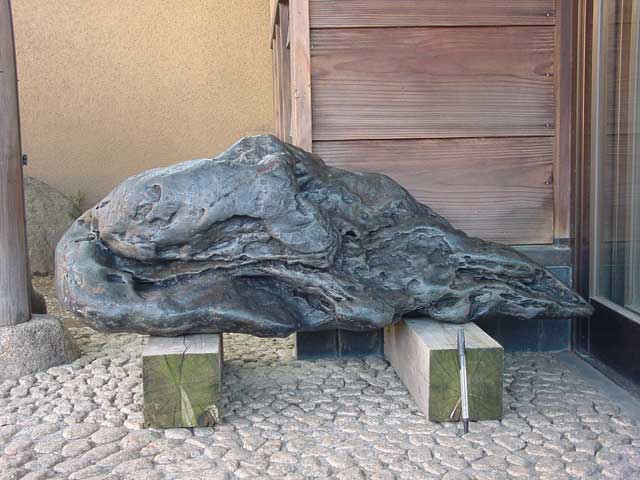
Ben Nanjo (San Francisco Aiseki Kai) & Felix Rivera (California Suiseki Society) speak of hard, very dense & finely grained stones (several varieties from N. California rivers) receiving hand-rubbing. Felix has even spoken of meiseki created in months if not weeks by handrubbing the right stone. I imagine they honor their teachers in the practice, and not denying their roots is commendable. Keiseki Hirotsu who with one, & later two, other Japanese-American enthusiasts formed the first Western suiseki club in Palo Alto, California (~1966) seems among contenders for establishing practice at that time. I can see many of his stones on Felix Rivera's website, read of him through San Francisco Aiseki Kai friends including Mas Nakajima and marvel. Others on IBC & throughout California know more of Mr. Hirotsu's practice-- he died in 1987 but lives through continuing appreciation.
In the latest California Aiseki Kai newsletter (available online), I thought Jim Greaves (the "Guy Jim" column) chose wonderfully in noting some stone display practices as "Japanese-American Tradition." He was primarily referring to mounting bonsai & suiseki in the same display where one was the principal display object, but the traditions of early clubs & sensei might extend much further.
Folks on the USA East Coast & in Europe are more familar, perhaps, with the Nippon Suiseki Association publications & practices that differ from Japan's Zen Nipon Aiseki Kyokai (All Japan Stone Lover(s) Association). Aiseki Kyokai practices published with variations by the two Mr. Murata(s), Mr. Takehashi & Mr. Nagase occurred at the same time suiseki practice was growing in California. When in 1988, both Nippon Suiseki Association & Aiseki Kyokai published books on important Japanese stones, the formats & naming varied modestly between the two. Some California suiseki publishers referring to Japanese stones (e.g., Ben Nanjo's Unkon Fu) typically choose the Aiseki Kai format where it differs. The Japanese Ministry of Cultural Affairs has charged Nippon Suiseki Association with promulgating the tradition of suiseki since its establishment ~ 1961.
Ben Nanjo does a good job of explaining hand-rubbing in very limited context. Handrubbing & light oiling were once widely recommended (mid to late 1990s) for a wide variety of stones in North America with many being irrevocably stained or, at best, retarded from establishing a skin. A yoseki-practice aging would attract & retain humidity from the air and/or watering rather than requiring oiling or handrubbing. Oil-dependent translucence can never reflect changes in humidity & is likely to reduce natural stone translucence, in my opinion & limited experience.
To my mind, the best skin for dense, deeply-colored, hard stones takes much longer for aging than for less dense stones. They open pores and wear more slowly.
I would not choose a suiban for your stone or water it beyond cleaning for aging. Dusting/polishing with a clean, dry cloth over time might encourage a skin to form that closely holds humidity. The beeswax will affect the stone slightly (or perhaps more) underneath the surface slowly built by dusting. The worse scenario is adding oil or wax until a primarily black stone turns brown & only looks translucent when re-oiled.
A French enthusiast (not Marco, though Marco knows him) once posted a glossy, apparently-oiled limestone on this forum. He crowed about his dry rubbing technique to perfect the surface in only a year's time. He seemed so convinced of the practice that I think he believed the result came from his latest efforts. Don't believe all you read-- especially question anything I suggest (my wrong turns are numerous). I've had limestone literally sit unattended in a garage with no treatment and turn significantly darker-- especially the Ligurian limestone for which Marco is much more familiar than I. I haven’t dusted any stone daily, ever… but I believe the practice makes sense in a variety of ways similar to the experience of watering bonsai by hand, daily. I water many stones requiring it on the same schedule as bonsai & keep a few in my showering room which show substantive change with humidity—that is not any learned practice but suits my appreciation. When humidity is high in Virginia (especially in the month of August), my stones are often clear scales through changing depth of color.
I've shown the picture of a repeatedly oiled stone before. It was once featured in a Japanese suiseki exhibit as a Kamogawa stone with the famed jet-black finish. I only have a photo a couple of days after a recent oiling. When wet it looked mostly deep brown. Before oiling it was horrendously dry & light in color.
You can unpack this, James, to determine a practice which meets your needs.
Oiled & soon drying, stained Kamogawa-ishi:


Chris Cochrane- Member
 Lots to know
Lots to know
Thanks Chris,
There is lots to know and would take many years (part of the fun) to learn and abuild up a good luster to the stone. First i will tackle the dia and see how it looks.
That is a stunning stone you have shown looks big, do you show it free standing or on a stand?
Thanks James
There is lots to know and would take many years (part of the fun) to learn and abuild up a good luster to the stone. First i will tackle the dia and see how it looks.
That is a stunning stone you have shown looks big, do you show it free standing or on a stand?
Thanks James

jamesransom- Member
 Re: A stone i found near were i live
Re: A stone i found near were i live
Hi James... It is a huge stone-- perhaps slightly over a meter in length. The stone's vendor owned a catalog displaying the stone in a daiza (now lost)-- I'd guess it was a pre-War exhibit, auction catalog or perhaps a memorial catalog associated with sales of a specific collector's collection. The National Bonsai & Penjing Museum has some of these catalogs. The Director of the U.S. National Arboretum Dr. Tom Ehias arguably has an even deeper private collection of publications-- especially in regard to suiseki.
Kunio Kobayashi had this stone when I saw it. He has an extraordinary private library & generously shared it while I was studying in Japan. Mr. Kobayashi additionally has many catalodgs & books pass through his hands. Some perhaps travel with extraordinary pots he collects-- very old publications clarifying the cultural history of much older pots-- many from Chinese kilns. I don't read Japanese, but occasionally Mr. Kobayashi would have Peter Warren (his senior apprentice) describe the history of a pot he was describing and pull out a musty catalog... :-)
Kunio Kobayashi had this stone when I saw it. He has an extraordinary private library & generously shared it while I was studying in Japan. Mr. Kobayashi additionally has many catalodgs & books pass through his hands. Some perhaps travel with extraordinary pots he collects-- very old publications clarifying the cultural history of much older pots-- many from Chinese kilns. I don't read Japanese, but occasionally Mr. Kobayashi would have Peter Warren (his senior apprentice) describe the history of a pot he was describing and pull out a musty catalog... :-)

Chris Cochrane- Member
 Similar topics
Similar topics» TUNNEL STONE
» Potomac Viewing Stone Group-- Chinese stone preferences
» Some picture stone and black stone for your appreciation
» Yuhua Stone (Rain Flower Stone)
» MOUNTAIN LANDSCAPE ( Cut stone and Uncut stone )
» Potomac Viewing Stone Group-- Chinese stone preferences
» Some picture stone and black stone for your appreciation
» Yuhua Stone (Rain Flower Stone)
» MOUNTAIN LANDSCAPE ( Cut stone and Uncut stone )
Page 1 of 1
Permissions in this forum:
You cannot reply to topics in this forum|
|
|








